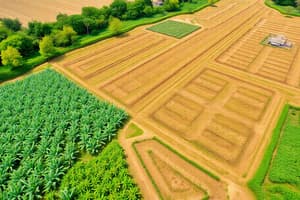Podcast
Questions and Answers
What percentage of global cultivated land is classified as prime quality?
What percentage of global cultivated land is classified as prime quality?
- 70%
- 53%
- 40%
- 28% (correct)
Soil degradation leads to an increase in crop yields.
Soil degradation leads to an increase in crop yields.
False (B)
What is the primary use of land in the food system?
What is the primary use of land in the food system?
Food production
The total global land area is approximately ___ million km2.
The total global land area is approximately ___ million km2.
What is the main limiting factor for crop production in many areas?
What is the main limiting factor for crop production in many areas?
What percentage of water is used for irrigated agriculture?
What percentage of water is used for irrigated agriculture?
What are the three classes of cropland potential according to the FAO?
What are the three classes of cropland potential according to the FAO?
Water is considered a non-renewable resource in all contexts.
Water is considered a non-renewable resource in all contexts.
What is a key characteristic of water as a natural resource?
What is a key characteristic of water as a natural resource?
Which type of agriculture depends on 'green' water?
Which type of agriculture depends on 'green' water?
The average daily water use for food production per capita is nearly ___ liters.
The average daily water use for food production per capita is nearly ___ liters.
What are some negative consequences of inefficient water use?
What are some negative consequences of inefficient water use?
What major factor increases the demand for cropland?
What major factor increases the demand for cropland?
Flashcards are hidden until you start studying
Study Notes
Land Use and Food Systems
- Food production activities heavily rely on natural resources, particularly land and water.
- Total global land area is approximately 149 million km², with 15 million km² for crop production and 34 million km² for rangelands.
- Croplands are the largest food producers globally; other food sources include fisheries, hunting, and rangelands.
- Soil quality, slope, and climate determine land suitability for agriculture.
Land Potential
- Not all land can sustainably support agriculture; land potential is influenced by production capability and resistance to degradation.
- FAO categorizes cropland potential into three classes: Prime (28%), Good (53%), and Marginal/Unsuitable.
- Prime land offers greater productivity levels for inputs like labor and nutrients.
- Effective management can enhance land quality, while poor practices lead to degradation.
Efficient and Sustainable Use of Land
- Higher crop yields can improve labor productivity and economic outcomes, potentially reducing deforestation pressures.
- However, local efficiency can lead to increased global demand for crops, lowering prices and affecting agricultural dynamics.
Unsustainable Use of Land
- Soil degradation affects fertility, caused by erosion, nutrient depletion, chemical toxicity, and physical degradation.
- Approximately 33% of Earth's land faces some soil degradation.
- Restoration projects, such as windbreaks, can improve land quality and combat erosion.
Consequences of Inefficient Land Use
- Without improved efficiency, food demand will expand cropland, threatening biodiversity and ecosystem services.
- Land degradation correlates with declining livelihoods and a lack of investment capacity, particularly affecting the poor.
- Sustainability assessments for land use should consider impacts over hundreds or thousands of years.
Future Land Use
- Growing demand for food is driving cropland expansion, often encroaching on natural habitats.
- Factors influencing cropland needs include biofuel demand and soil degradation.
Water and Food Systems
- Freshwater is critical for food production, processing, and waste management, with an average of 4,000 liters needed for daily food production per capita.
- Rain-fed agriculture utilizes 'green' water, while irrigated agriculture combines 'green' and 'blue' water, with irrigated systems accounting for 70% of global blue water use.
Characteristics of Water as a Resource
- Water is part of the natural cycle and cannot be simply extracted; its availability is localized and often limited.
- Approximately one-third of the global population experiences medium to high water stress.
Unsustainable Use of Water
- Current irrigation methods often lead to unsustainable surface water usage, negatively impacting ecosystems.
- Groundwater, a key irrigation resource, faces overexploitation, affecting aquifer levels and availability.
- At least 20% of global groundwater aquifers are overused, particularly in Asia and North America.
Case Study: Groundwater Irrigation in India
- Groundwater constitutes over 60% of irrigation and 85% of drinking water in India.
- Due to energy subsidies and easy access to pumps, groundwater use has surged, jeopardizing recharge rates.
Water-Use Efficiency
- Water-use efficiency focuses on the ratio of water delivered to plants versus yield produced, revealing current inefficiencies.
- Losses of 50% of water are common due to traditional irrigation methods and mismanagement.
Consequences of Inefficient Water Use
- Unsustainable practices lead to rapid depletion of water resources, lower yields, and diminished future availability for agriculture and ecosystems.
Future Water Use
- Despite anticipated production increases, agricultural water use may slightly decline; however, climate change may strain water availability.
- By 2050, 40% of the population is expected to live in severely water-stressed river basins, influenced by urbanization and changing sectoral demands for water.
Climate Change Impacts on Water
- Climate change will significantly alter water availability through changes in precipitation, runoff, and groundwater recharge.
- Potential consequences include intensified droughts and the salinization of coastal freshwater resources.
Studying That Suits You
Use AI to generate personalized quizzes and flashcards to suit your learning preferences.




